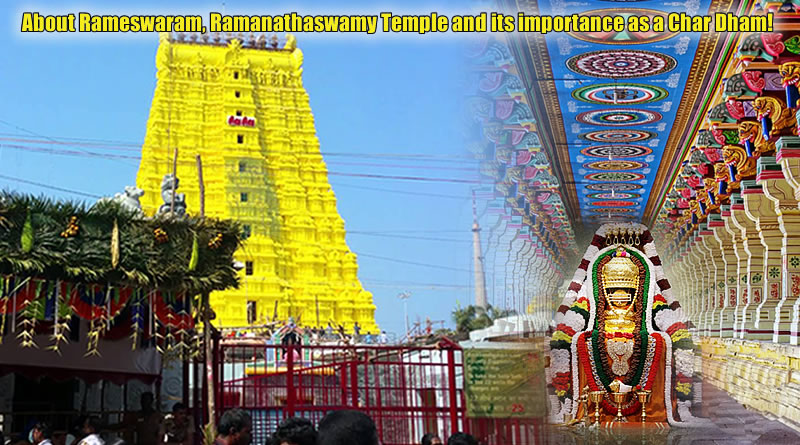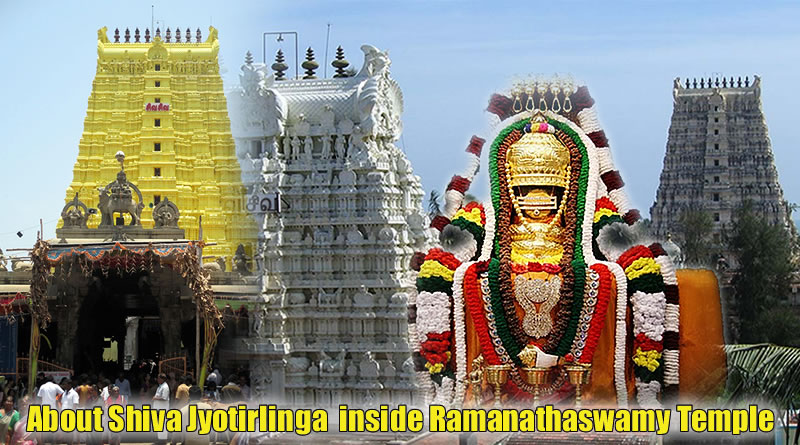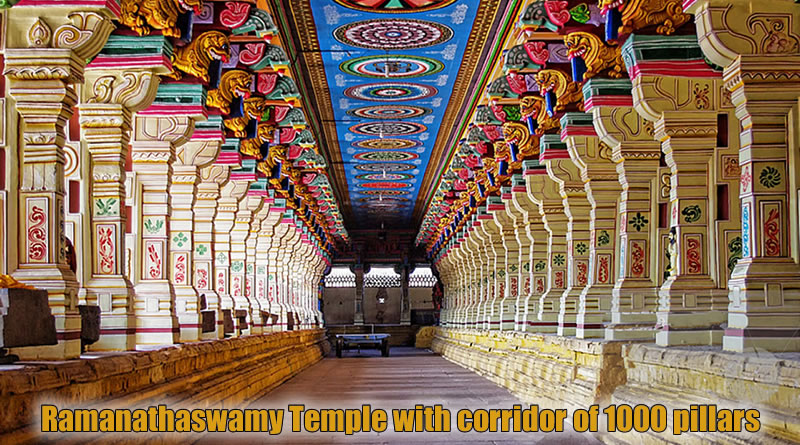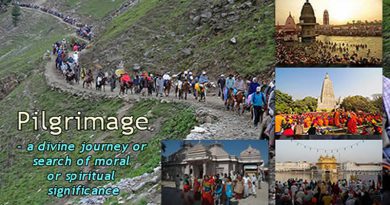About Rameswaram, Ramanathaswamy Temple and its importance as a Char Dham!
Rameswaram is one of the significant Dham in all four Char Dham. Rameswara means “Lord of Rama” in Sanskrit, a moniker of Shiva, the presiding god of the Ramanathaswamy Temple. As per to Hindu epic Ramayana, Rama, the seventh avatar of the god Vishnu, prayed to Shiva here to forgive any sins that he might have committed during his war against the demon-king Ravana in Sri Lanka.
About Rameswaram Town:
Rameswaram – A Char Dham, (also mentioned as Ramesvaram, Rameshwaram or Ramisseram) is a town and a second grade municipality in the Ramanathapuram district in the South Indian state of Tamil Nadu, India. It is situated on Pamban Island separated from mainland India by the Pamban channel and is about 50 kilometers from Mannar Island, Sri Lanka. It is located in the Gulf of Mannar, at the very tip of the Indian peninsula. Pamban Island, also known as Rameswaram Island, is linked to mainland India by the Pamban Bridge. Rameswaram is the terminus of the railway line from Chennai and Madurai. Alongside Varanasi, it is also considered to be one of the holiest places in India to Hindus, and part of the Char Dham pilgrimage.
Rameshwaram is a famous tourist destination in Tamil Nadu. Noteworthy other tourist attractions in Rameshwaram are Agniteertham, Gandhamadhana Parvatam, Sri Ramanathaswamy Temple and Five-laced Hanuman Temple. Locals have faith in that taking bath in Agniteertham washes away personal sins. Built facing the east, this temple has a holy lake. There are 22 wells here and water from each well has a different taste. The water here is believed to have medicinal properties. The Ramanathaswamy Temple is a main attraction and it is one of the seven places visiting which one can gain salvation. The Ramayana was conceived here and it also houses one of the 12 jyotirlingas of Lord Shiva. Gandhamadhana Parvatam is a two storey temple with an imprint of Lord Rama on a chakra. Devotees come here to seek the blessings of Lord Rama.
As per to Hindu mythology, this is the place from where the Hindu god Rama built a bridge, across the sea to Lanka to rescue his wife Sita from her abductor Ravana. The Ramanathaswamy Temple devoted to the Hindu god Shiva is located at the center of the town and is closely related with Rama. The temple along with the town is considered a divine pilgrimage site for both Shaivites and Vaishnavites.
Rameswaram is the nearby point to reach Sri Lanka and geological proof suggests that the Adam’s Bridge was a prior land connection between India and Sri Lanka. The town is in news over alleged attack by Sri Lankan navy for alleged cross border activities by fishermen, Sethusamudram Shipping Canal Project, Kachchatheevu and Sri Lankan Tamil refugees.
Rameswaram is managed by a municipality established in 1994. The town covers an area of 53 km2 and had a population of 44,856 as of 2011. Tourism and fishery provide the employment to the majority of workforce in Rameswaram.
Geographical site of Rameswaram:
Rameswaram has an average elevation of 10 metres (32 feet). The island is spread across an area of 61.8 square kilometres and is in the shape of a conch. 74% of the area has sandy soil due to the presence of sea and it has many islands surrounding it, the Palk Strait in the north west and Gulf of Mannar in the south East. The Ramanathaswamy Temple occupies major area of Rameswaram. The beach of Rameswaram is featured with no waves at all – the sea waves rise to a maximum height of 3 cm and the view looks like a very big river. Rameswaram has dry tropical climate with low humidity, with average monthly rainfall of 75.73 mm, mostly from North East monsoon from October to January. The highest ever temperature recorded at Pamban station was 37 °C and the lowest was 17 °C.
Adam’s Bridge is a chain of limestone shoals, between Rameswaram and Mannar Island, off the northwestern coast of Sri Lanka. Geological indication suggests that this bridge is a former land connection between India and Sri Lanka. The bridge is 18 miles (30 km) long and separates the Gulf of Mannar (South West) from the Palk Strait (North East). It was supposedly passable on foot up to the 15th century until storms deepened the channel.
The temple’s ancient history reveals that Rama’s Bridge was completely above sea level until it broke in a cyclone in 1480 CE. The bridge was first stated in the ancient Indian Sanskrit epic Ramayana of Valmiki. The name Rama’s Bridge or Rama Setu (Sanskrit; setu: bridge) refers to the bridge built by the Vanara (ape men) army of Rama in Hindu mythology, which he used to reach Lanka and rescue his wife Sita from the demon king Ravana. The Ramayana attributes the building of this bridge to Rama in verse 2-22-76, naming it as Setubandhanam. The sea separating India and Sri Lanka is called Sethusamudram meaning “Sea of the Bridge”. Maps prepared by a Dutch cartographer in 1747 CE, available at the Tanjore Saraswathi Mahal Library show this area as Ramancoil, a colloquial form of the Tamil Raman Kovil (or Rama’s Temple).
About Rameswaram temple and its architecture:
Ramanathaswamy Temple is a Hindu temple devoted to god Shiva located on Rameswaram island in the state of Tamil Nadu, India. It is one of the 275 Paadal Petra Sthalams, where the three of the most revered Nayanars (Saivite saints), Appar, Sundarar and Tirugnana Sambandar, have glorified the temple with their songs. The temple was expanded during the 12th century by Pandya Dynasty, and its principle shrines were refurbished by Jeyaveera Cinkaiariyan and his successor Gunaveera Cinkaiariyan of the Jaffna kingdom. The temple has the longest corridor among all Hindu temples in India. The temple is located in Rameswaram, an island town in South India, considered a divine pilgrimage site for Shaivites, Vaishnavites and Smarthas. The temple is also one of the twelve Jyothirlinga temples, where Shiva is worshipped in the form of a Jyotirlingam (pillar of light).
The Ramanathaswamy Temple is famous for its architecture. The granite pillars are supporting the corridor in the precinct of Ramanathaswamy Temple. It has corridor of 1000 pillars. The Ramanathaswamy Temple is the most famous historic landmark of the town. Located in the center of town, Ramanathaswamy Temple is a well-known Hindu temple devoted to the god Shiva. The temple is one of the 12 Jyotirlinga shrines, where Shiva is worshipped in the form of a Jyotirlinga meaning “pillar of light”. It is also one of the 275 Paadal Petra Sthalam temples and is glorified in hymns by the three of the most revered Nayanar saints (7th century Saivite saints), Appar, Sundarar and Tirugnana Sambandar. The temple in its current structure was built during the 12th century by Pandya Dynasty. The temple has the longest corridor among all Hindu temples in India. The breadth of these columned corridors varies from 17 to 21 feet with a height of 25 feet. Each pillar is carved in Nayak style as in Madurai Meenakshi Amman Temple. The contribution of the kings of the Sethupathy dynasty (17th century) to the temple was significant. Large amount of money was spent during the tenure of Pradani Muthirulappa Pillai towards the renovation of the pagodas which were falling into ruins – the Chockattan Mantapam or the cloistered precincts of the temple was reconstructed by him.
The rulers of Sri Lanka contributed to the temple – Parakrama Bahu (1153–1186 CE) was involved in the construction of the sanctum sanctorum of the temple. The eastern tower and shrine of Nataraja were built by Dalavai Sethupathy in 1649 CE. The second enclosure is ascribed to Chinna Udayar Sethupathy and his son Ragunatha Thirumalai (1500–1540 CE). The third enclosure was constructed by Muthu Ramalinga Sethupathy (1725–1771 CE) – his statue is located in the entrance of the corridor.
The primary god of the temple is Ramanathaswamy (Shiva) in the form of lingam. There are two lingams inside the sanctum – one built by Goddess Sita, from sand, residing as the main deity, Ramalingam and the one brought by Lord Hanuman from Kailash called Vishwalingam. Rama instructed that Vishwalingam should be worshipped first since it was brought by Lord Hanuman – the ritual continues even today.
Rameswaram history and its associated Myths:
Rameswara means “Lord of Rama” in Sanskrit, a moniker of Shiva, the presiding god of the Ramanathaswamy Temple. As per to Hindu epic Ramayana, Rama, the seventh avatar of the god Vishnu, prayed to Shiva here to forgive any sins that he might have committed during his war against the demon-king Ravana in Sri Lanka.
As per to the Puranas (Hindu Holy Books), upon the recommendation of sages, Rama along with his wife Sita and his brother Lakshmana, installed and worshipped the lingam (an iconic symbol of Shiva) here to expiate the sin of Brahmahatya incurred while killing of the Brahmin Ravana. To worship Shiva, Rama wanted to have the largest lingam and directed his monkey lieutenant Hanuman to bring it from Himalayas. Since it took longer to bring the lingam, Sita built a small lingam, which is believed to be the one in the sanctum of the temple. This account is not supported by the original Ramayana authored by Valmiki, nor in the Tamil version of the Ramayana authored by Tamil poet, Kambar (1180–1250 CE). Support for this account is found in some of the later versions of the Ramayana, such as the one penned by Tulasidas (15th century).
Sethu Karai is a place 22 km before the island of Rameswaram from where Rama is believed to have built a floating stone bridge, the Adam’s bridge that further continued to Dhanushkodi in Rameswaram till Talaimannar in Sri Lanka. As per to another version, as quoted in Adhyatma Ramayana, Rama installed the lingam before the construction of the bridge to Lanka.
The history of Rameswaram is centered on the island being a transit point to reach Sri Lanka (Ceylon historically) and the presence of Ramanathaswamy Temple. Tevaram,the 7th–8th century Tamil compositions on Shiva by the three prominent Nayanars (Saivites) namely Appar, Sundarar and Thirugnanasambandar. The Chola king Rajendra Chola I (1012 – 1040 CE) had a control of the town for a short period. The Jaffna kingdom (1215–1624 CE) had close links with the island and claimed the title Setukavalan meaning custodians of the Rameswaram. Hinduism was their state religion and they made large contribution to the temple. Setu was used in their coins as well as in inscriptions as marker of the dynasty.
About Rameswaram – A Char Dham Pilgrimage:
Rameswaram is important for many Hindus as a pilgrimage to Varanasi is considered to be incomplete without a pilgrimage to Rameswaram. The town along with the Ramanathaswamy temple is one of the holiest Hindu Char Dham (four divine sites) sites comprising Badrinath, Puri and Dwarka.
Though the origins are not evidently known, the Advaita school of Hinduism established by Sankaracharya, attributes the origin of Char Dham to the seer. The four monasteries are located across the four corners of India and their attendant temples are Badrinath Temple at Badrinath in the North, Jagannath Temple at Puri in the East, Dwarakadheesh Temple at Dwarka in the West and Ramanathaswamy Temple at Rameswaram in the South.
Though ideologically the temples are divided between the sects of Hinduism, namely Saivism and Vaishnavism, the Char Dham pilgrimage is all Hindu affairs. The journey across the four cardinal points in India is considered sacred by Hindus who aspire to visit these temples once in their lifetime. Traditionally the trip starts at the eastern end from Puri, proceeding in clockwise direction in a manner typically followed for circumambulation in Hindu temples.
Suitable Time to Visit Rameswaram:
The best period to visit Rameshwaram is between October and April.
How to reach Rameswaram – A Char Dham:
Rameshwaram is reachable by air, railways and roadways. It is well connected by rail with cities like Chennai, Coimbatore, Thanjavur and Trichy. The nearest airport is in Madurai, 163 km from here. If you are traveling from some distant location then taking a flight will be the best choice.
A trip here will bring a serene feeling in your mind tired with the complexities of modern life. State transport buses regularly travel between Rameshwaram and other cities of Tamil Nadu. Hotels and guest houses provide the best facilities you can possibly have here.
By Air:
Rameshwaram does not have an airport. Nearest airport is Madurai Airport.
1. Madurai Airport (IXM), Madurai, Tamil Nadu (149 km away from Rameshwaram)
2. Tuticorin Airport (TCR), Thoothukudi, Tamil Nadu (142 km away from Rameshwaram)
By Railway:
After completion of bridge, metre-gauge lines were laid from Mandapam up to Pamban Station, from where the railway lines bifurcated into two directions, one towards Rameswaram about 6.25 miles (10.06 km) up and another branch line of 15 miles (24 km) terminating at Dhanushkodi.
There are daily express trains connecting major cities in Tamil Nadu like Chennai, Madurai, Trichy and Coimbatore. There are weekly express trains connecting Coimbatore, Varanasi and Bhubaneswar. Passenger trains ply from Rameswaram to Madurai and Trichy daily, making railways as the major mode of transportation.
Railway Station Code: Rameswaram (RMM)
By Road:
There are regular buses from other major cities of the country to Rameshwaram.
The Ramanathapuram – Rameswaram National Highway is the main connecting link from Rameswaram to the mainland. The National highway NH 49 connects Madurai to Dhanushkodi, linking major towns like Manamadurai, Paramakkudi, and Ramanathapuram in the Ramanathapuram district. The Rameswaram municipality covers a total road length of 52 km and 20 km of national highway covering about 80 percent of the town. The Tamil Nadu State Transport Corporation runs daily services connecting various cities to Rameswaram and operates a computerized reservation centre in the municipal bus stand of Rameswaram.
Distance between New Delhi to Rameshwaram and Madurai:
1. The driving distance between New Delhi and Rameshwaram is 2747 km, while the aerial distance from New Delhi to Rameshwaram is 2163 km.
2. Distance between New Delhi and Madurai: 2083 kms
3. Distance between Madurai and Rameshwaram: 172 kms
Rameshwaram Temple at Google Map:
If you need any help regarding Hindu Pilgrimage or Hindu Pilgrimage related information, please leave your message at our Pilgrimage Help Centre or comment box.
All this information is free and only for informational purpose.







